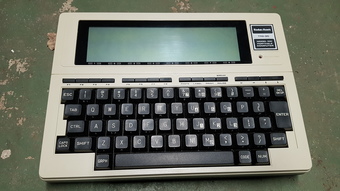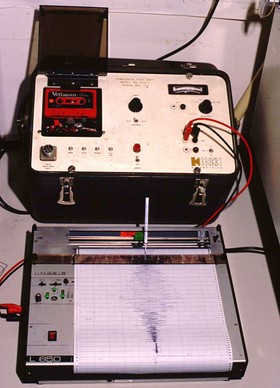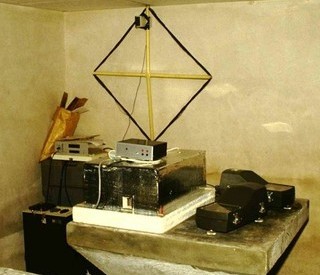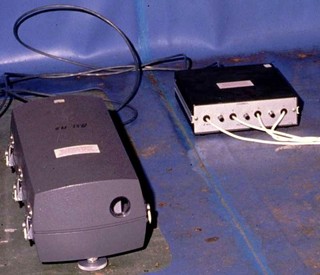Europe
NARS Europe (1983 – 1987)
NARS was initiated by Nolet (Nolet & Vlaar, 1982) to investigate the European upper mantle structure using higher mode surface waves. Thus, the NARS-Europe configuration was set up as a antenna from Southern Sweden to South Spain directed towards the NW Pacific seismic belt. The 14 stations of NARS-Europe which were operative from 1983 till 1988 have provided a wealth of broadband data that since then have been employed for a large number and a great variety of seismological studies. Some stations were moved during the course of the project which yields the 18 different locations shown below.

Station list & data
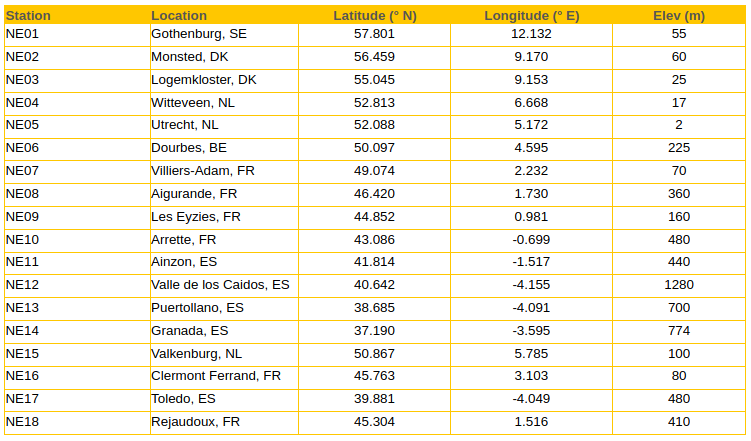
Alsina, D., Broadband seismological data studies; Validity of assumptions in surface wave studies and detailed structure of the upper mantle, Geologica Ultraiectina, 138, 163 pp., 1996.
Dost, B., Preliminary results from higher-mode surface-wave measurements in western Europe using the NARS array, Tectonoph., 128, 289-301, 1986.
Dost, B., The NARS array: a seismic experiment in Western Europe, PhD. Thesis, 1987.
Dost, B., A. van Wettum, and G. Nolet, The NARS array, 2Geol. Mijnb., 64, 381-386, 1984.
Herraiz, M., and B. Dost, El proyecto NARS: The NARS project, Rev. de geofisica, 41, 53-64, 1985.
Hof, E., and G. Nolet, Q under NARS, preliminary results, in Proceedings of the Fourth EGT Workshop, edited by Nolet, G. and B. Dost, pp. 129-132, European Science Foundation, Strasbourg, 1988.
Lomax, A., and R. Snieder, The contrast in upper-mantle shear-wave velocity between the East European Platform and tectonic Europe obtained with genetic algorithm inversion of Rayleigh-wave group dispersion,Geophys. J. Int., 123, 169-182, 1995.
Marquering, H., Surface wave mode coupling: Modelling and inverting waveforms including body-wave phases, Geologica Ultraiectina, 137, 150 pp., 1996.
Marquering, H., R. Snieder, and G. Nolet, Waveform inversions and the significance of surface wave mode coupling, Geophys. J. Int., 124, 258-278, 1996.
Neele, F., and R. Snieder, Are long-period body wave coda caused by lateral heterogeneity?, Geoph. J. Int., 107, 131-153, 1991.
Nolet, G., Het NARS project, Natuur en Techniek, 52, 538-552, 1984.
Nolet, G., Partitioned waveform inversion and two-dimensional structure under the network of autonomously recording seismographs, J. Geophys. Res., 95, 8499-8512, 1990.
Nolet, G., and N.J.Vlaar, The NARS project: probing the Earth’s interior with a large seismic antenna, Terra Cognita, 2, 17-25, 1982.
Nolet, G., B. Dost, and H. Paulssen, The upper mantle under Europe: An interpretation of some preliminary results from the NARS project, Geol. Mijnb., 65, 155-166, 1986.
Nolet, G., B. Dost, and H. Paulssen, Intermediate wavelength seismology and the NARS experiment, Ann. Geophysicae, 4, 305-314, 1986.
Nolet, G., B. Dost, and H. Paulssen, The NARS array (1983-1990), in Proc. Ist workshop on MedNet:The broad-band seismic network for the Mediterranean, edited by E. Boschi, D. Giardini and A. Morelli, pp. 76-82, 1991.
Paulssen, H., Upper mantle converted waves beneath the NARS array, Geophys. Res. Lett., 12, 709-712, 1985.
Paulssen, H., Lateral heterogeneity of Europe’s upper mantle as inferred from modelling of broad-band body waves, Geophys. J. R. astr. Soc., 91, 171-199, 1987.
Paulssen, H., Evidence for a sharp 670-km discontinuity as inferred from P to S converted waves.,J. Geophys. Res., 93, 10489-10500, 1988.
Paulssen, H., Small scale structure of the upper mantle, PhD thesis, Utrecht University, 1988.
Paulssen, H., and E. Stutzmann, On PP-P differential travel time measurements, Geophys. Res. Lett., in press, 1996.
Snieder, R., Surface wave scattering theory, with applications to forward and inverse problems in seismology, PhD Thesis, Geologica Ultratraiectina, 50, 1987.
Snieder, R., Large-Scale Waveform Inversions of Surface Waves for Lateral Heterogeneity, 2, Application to Surface Waves in Europe and the Mediterranean, J. Geophys. Res., 93, 12067-12080, 1988.
Visser, J., and H. Paulssen, The crustal structure from teleseismic P-wave coda; 2. Application to data of the NARS array in western Europe, Geophys. J. Int., 112, 26-38, 1993.
Zielhuis, A., S-Wave velocity below Europe from delay-time and waveform inversions, PhD Thesis, Geologica Ultraiectina, 88, 148 pp., 1992.
Zielhuis, A., and G. Nolet, Shear-wave velocity variations in the upper mantle beneath Central Europe, Geophys. J. Int., 117, 695-715, 1994.
Equipment
Datalogger
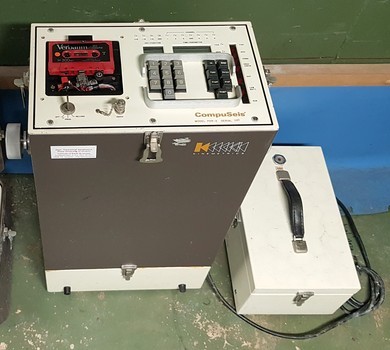 The Kinemetrics digital event recorder PDR-2 was one of the first mobile data loggers equipped with a microprocessor and therefore had a very low energy consumption. In the event of a power failure internal batteries took care to bridge this time. Data storage was done on a cassette tape. A 12 bit analog to digital converter (ADC) with gain ranging gave a dynamic range of more than 100dB. Time could (optionally) be synchronized with the GOES satellite, but due to the unfavorable position it could not be used at our locations. Alternatively we use the German long wave time signal called DCF77.
The Kinemetrics digital event recorder PDR-2 was one of the first mobile data loggers equipped with a microprocessor and therefore had a very low energy consumption. In the event of a power failure internal batteries took care to bridge this time. Data storage was done on a cassette tape. A 12 bit analog to digital converter (ADC) with gain ranging gave a dynamic range of more than 100dB. Time could (optionally) be synchronized with the GOES satellite, but due to the unfavorable position it could not be used at our locations. Alternatively we use the German long wave time signal called DCF77.
Data storage was approximately 10 hours at a sample rate of 125 ms. Due to the limited storage capacity, a trigger algorithm based on the short (STA) and long term (LTA) average had to be used.
Playback
The cassettes could be read on a PDR-2 which was connected to a computer. With a separate reading unit, the “Compuseis model CTU-1” and a chart recorder, the signal could also be displayed in the field. Later a TRS-80 portable computer was used for this. A plot program, written in “Basic”, showed the signal on a small LCD screen. Not a high accuracy, but a lot easier to carry than the CTU-1 with chart recorder.
- TRS-80
- CTU-1 with Linseis chard recorder
Seismometers
The seismometer setup consisted of two horizontal Kinemetrics SL-220 and one vertical SL-210 seismometer. The sensors are tuned to an eigenperiod of 12 seconds and by using a preamplifier with shaping filter, the lower frequencies are significantly exhanced. This made the seismometers very temperature sensitive and is was therefore placed in a temperature controlled polystyrene box. A double-walled box, the inner box of which was lined with stone, was kept electronically at a fixed temperature.
- (a) NE18 Rejaudoux, France
- (b) SL-210 and pre-amplifier
(a) On the concrete pillar the temperature-controlled box can be seen. It houses the vertical SL-210 and the two horizontal SL-220 sensors (at N-S and E-W directions). The PDR-2 is visible to the left, and also the DCF-77 time signal receiver. The plastic cross is a tuned circuit, consisting of a large number of wire turns and serial capacitor, tuned to a resonance frequency of 77.5 Khz. A DCF77 antenna, placed within this loop (top cross), significantly improves reception. (b) The vertical SL-210 sensor connected to the pre-amplifier.
Timing
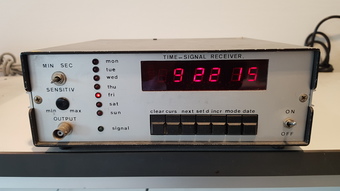
For time synchronization a DCF77 receiver, design by Elektor (1981), was built and modified to automatically synchronize the PDR-2’s internal clock to the nearest second. DCF77 is a German standard frequency long wave time signal and radio station near Frankfurt am Main broadcasting at 77.5 KHz. The signal carries an amplitude modulated, pulse width coded 1 bit/s data signal. A 0.1 second pulse is a digital “0” and 0.2 second a “1”. The whole minute is marked by the absence of the 59th second. The receiver converts this into a pulse that is superposed on the E/W signal of the PDR-2 data logger. It served as an extra check, should the clock elapse for more than 0.5 second due to circumstances.


